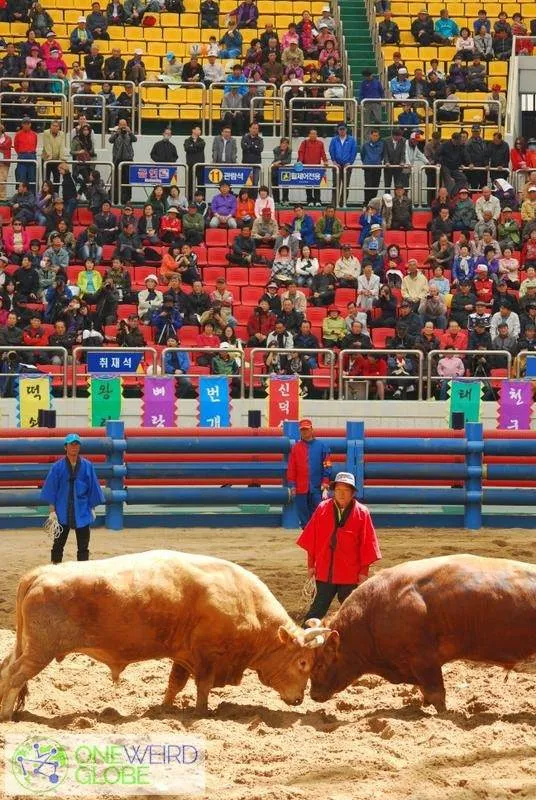
One experiences some unusual things while living in Korea. While bullfighting isn’t an unusual sport, it does bring to mind a centuries-old tradition that seems better left in the past. Five days a year, the festival brings forth that tradition, combining it with the modern touches Korean festivals all seem to have and a healthy government budget.

Arriving in Cheongdo requires a combination of 21st and 20th century traveling. The 300km/h KTX can take you to Daegu, but you’ll need to hop on a third-class Mugunghwa train to actually reach Cheongdo station. Once there, walk to the street and hop into a waiting taxi, or trek a couple hundred meters to reach the weather-worn bus terminal — a reminder that the festival hasn’t affected other aspects of the county.
It’s about halfway through the bus ride to the festival that the festivities becomes apparent. The colorful banners, the traffic cones, and traffic that comes with a festival all combine to create the atmosphere of a Big Deal. Despite the crowd of several thousand, it still seemed there were far more volunteers than needed — having literally a dozen people to direct two lanes worth of traffic seems unnecessary at best and dangerous at worst.
Getting in (5,000 won admission) was easy enough, as was finding a brochure, which was offered in more than enough places. The pamphlet’s English, while mangled in a few places and offering the website in Korean, was done well enough to pass muster.
The bullfighting stadium was not unlike a football stadium in grandeur, albeit smaller in size. 10,000 seats in tight rows and narrow aisles encourage people to stay put — and empower the steamed corn seller to magically move about the crowd. My friend the Qi Ranger also attended, and his video on the event is entertaining.

The animal-lovers may shudder at the thought of two bulls attempting to gore each other or force the other to back down. That their horns are significantly dulled helps to reduce injury and chance of death, but probably does nothing to reduce pain. The animals aren’t exactly docile either — while some matches feature more pushing and shoving than anything else, at least one of the trainers found himself at the wrong end of the opposing horns. (He was fine, and the other bull was disqualified.) For those that preferred to eat meat rather than watch it fight, frozen hanwoo was for sale, albeit at a premium price.

With no introduction to the sport, the foreign tourist could be forgiven for not knowing the rules. Instead of a matador showing their prowess of a cape, two bulls square off in the 30-meter dirt circle. Their handlers, which bring these beasts to the ring, do so through a rope that pulls on their nose ring. While it does little to placate the animal’s spirit, it is necessary to bring the pair head-to-head. With that accomplished, the bulls push, shove, and strike with trained proficiency. The trainers remain in the ring, and may shout, scream, or smack their own bull as they desire. The bull that backs down or runs away is the loser.
Even as the trainers have spent untold hours with their 700 kilogram animals, there seems little strategy or predictability to the sport. If there was a seeding system or some sort of ranking, it was completely lost on me. The sport becomes something like American football — watching the hits, tricks, and sly plays in between the commentary, timeouts, and pauses between contests.

That foreigners made up a significant percentage of the crowd — perhaps 5%, perhaps more — wasn’t overly surprising. The exoticness, combined with the billing of a top festival, offered an excellent opportunity to enjoy one of the first nice spring weekends. The mechanical bull made a nice appearance, while a convenience store sold enough alcohol to make a real bull woozy. On the permanent stage, an older Korean gentleman performed trot music in a neon yellow bikini top (not pictured — you’re welcome).

While there was ample English signage for the necessities and translators on-call, there were a few language problems. A number of local products were on sale, but from a distance there was little to draw in the foreign eye. While few foreigners are likely to buy a box of local peaches or flat persimmons at the premium price they command, the marketing efforts would still be appreciated.

As part of a weekend out, it was an entertaining afternoon offering plenty of activity. The dozens of tent restaurants outside the ticketed area had some customers, although the permanent Korean restaurants inside the stadium grounds had far more people. In between rounds of bullfighting, plenty of traditional Korean singing and dancing kept the crowd’s attention. The accordionist pumping out a techno song was the more unusual of the offerings, but was a welcome change of pace. Had I more time, a sign offered hints at the area’s other offerings: Unmunsa, a Buddhist temple; the Cheongdo wine tunnel; Cheongdo Eup Castle. The nation’s largest seokbinggo (an ice storage facility) was also around, for those who enjoy the more esoteric sights.
The brochure announced the coming of “permanent bullfighting” in September 2011 — a welcome opportunity to take in a unique Korean spectacle.
For more information about bullfighting in Cheongdo, go to http://청도소싸움.kr/ (Korean only).


